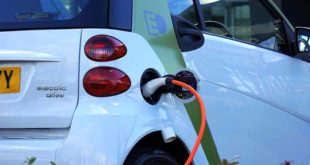GM was experimenting with electric car conversions as early as the 1960s. The Corvair and Chevette models were converted to electric, but never produced.
Then in 1987 came a racin in the sun; the solar powered auto race across Australia. The GM sponsored solar powered Sunraycer won. GM followed up with the 1990 Impact electric car. The car was aided in design by techincal experts AC Propulsion and Hughes electronics. The futuristic looking ride was the precursor of the EV1. The car was well ahead of the pack except for its lead acid battery bank.
1994, GM started up the PrEView program. The program provided 50 custom built Impact EVs for evaluation. 14,000 people applied to be testers. Motor Trend Magazine called the car “Fantastic”. A modified Impact hit a world record183mph.
In one of those interesting twists of fate, the Impact was so well received that it influenced the California Air Resources Board to craft the now famous and defunct Zero Emissions Vehicle (ZEV) mandate. The ruling specified increasing electric car production quotas from the major auto manufactures from 2% in 1998 to 10% in 2003. Gm appeared at first to be all with the mandate, Chevy S-10 pickup trucks were fitted with electric drive motors.
Then, Toyota, Honda, and Nissan showed their support by producing their own EV prototypes. Ford converted its Ranger pickup trucks to electric, and released the Ford TH!NK EV. Electric car conversions blossomed. EVs were indeed on a roll.
The Impact evolved into the 1996 EV1. The car was a hit from the start. Celebrities drove the car and provided free advertising. We remember the local TV anchorman driving the EV1 on camera while providing a steady stream of positive comments. Production was limited, and the EV1 could not be bought and paid for. The car could only be leased, but the future looked good for the electric car. 288 of the 1996 version with lead acid batteries were leased.
GM at this time was already expressing EV doubts in public. The company viewed the PreView program as a failure, yet continued with EV1 development, along with a promotional ad campaign. The hot-cold attitude of GM did not go unnoticed. Citizens repeatedly demonstrated support for the EV1, spending time and money on what they considered to be correct and well done.
In 1999, major improvements were made to the battery pack and drive electronics. In yet another curious move, the number of leases made available was restricted despite an increase in demand for the leases. GM did not seem to obey rational laws of supply and demand.
Then in a reversal, GM issued a recall for 450 EV1s. There were technical problems with the battery packs. 200 of the cars were re-fitted with Ni-MH battery packs.
In 1999, the EV1 production line was stopped after making some 1100 cars. In 2002, recalls of the EV1 were begun, consumers reacted. There were attempts at negotiation. There were protests. In the end, the cars were re-claimed and stored away in a warehouse. The EV1 program was officially ended in 2003. This is the same year that the CARB ruling regarding was repealed, aided by a phalanx of auto industry and cloaked oil company legal types.
The story ends with the crushing of nearly every single EV1. The efforts against EV1 smashing were many and well documented, as demonstrated in the film “Who Killed the Electric car”. Several GM executives have expressed remorse at this outcome.
Fast forward to 2010, GM has done another 180 degree turn. Now the company is planning to produce the Chevy Volt. GM has referred to the Volt as both an electric car, and a range extended electric vehicle (REEV). The strategy is working. People are lining up once again to purchase the latest GM electric powered car. The Volt is technically a Series Hybrid vehicle.
The new GM EV has the largest Hybrid battery pack out there at 16kWh. This Li-Ion pack is as large as the battery pack in some fully electric cars, like the Mitsubishi iMiev.
The car also has an onboard generator, and 4-cylinder gas engine. Unlike many other hybrids (GM included), the Volt engine only powers the generator, which in turn powers the electric drive motor. So, after the 40 mile or so range is extruded from the battery pack, the 4 banger kicks in and provides your extended range. The battery pack is only recharged by plugging it in. This also lends the label of “PHEV”, or plug in electric vehicle to the Volt.
GM has a history of producing winning electric cars. Lets hope the company stays the course and avoids anymore turn arounds in the middle of the electric highway.
 Alternative Energy HQ solar power for homes, wind energy, and bio fuel issues
Alternative Energy HQ solar power for homes, wind energy, and bio fuel issues







